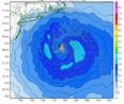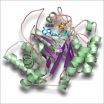(Press-News.org) Australian scientists have thrown new light on the mechanism behind the mass death of corals worldwide as the Earth's climate warms.
Coral bleaching, one of the most devastating events affecting coral reefs around the planet, is triggered by rising water temperatures. It occurs when the corals and their symbiotic algae become heat-stressed, and the algae which feed the corals either die or are expelled by the coral.
There have been seven major bleaching events globally in the past 30 years, the most recent being in 2010 across the Indian Ocean and Coral Triangle. Australia's Great Barrier Reef has suffered eight events since 1980, the worst being in 2002 when 55% of the total reef area was affected. The frequency of these events appears to be increasing.
Now a team of scientists from the ARC Centre of Excellence for Coral Reef Studies and James Cook University has shown that a complex cascade of molecular signals leading up to the self-inflicted death of corals and their symbiotic algae is triggered as sea water begins to warm.
Working with Acropora corals from the reef at Heron Island, the researchers found the cascade begins at ocean temperatures as much as 3 degrees lower than those normally associated with coral bleaching.
And the process culminates in 'apoptosis' or programmed cell-death – a situation in which living organisms (including corals and humans) deliberately destroy their weakened or infected body cells, effectively a form of 'cell suicide' or amputation designed to protect the organism as a whole.
"Our results suggest that the control of apoptosis is highly complex in the coral-algae symbiosis and that apoptotic cell death cascades potentially play key roles in tipping the cellular life or death balance during environmental stress prior to the onset of coral bleaching," explains lead author Dr Tracy Ainsworth.
"It is also clear that this chain reaction responds significantly to subtle, daily changes in the environment and to sea temperatures which were generally thought till now to have little impact on the function of coral and its symbiotic algae."
Paradoxically, the team's research identified molecular signals both promoting and discouraging programmed cell-death in the corals.
This has led them to a theory that corals respond to the stresses caused by warming sea water by killing off some of the cells, while strengthening others in order to stage a possible recovery after the hot water has moved off the reef and conditions have returned to normal.
"This would explain why some corals are able to recover quite quickly from a bleaching event, if it has not gone too far.
"It is far too early to speculate, but understanding the recovery process for any living organism is always a big help, as human medicine has constantly demonstrated, Dr Ainsworth says.
"The next step in our research will be to see how we can use this new insight into the processes of coral bleaching to understand their recovery mechanisms. We also need to know more about how this process works at lower temperatures, or under varying temperatures.
"That in turn will lead us to explore ways that coral reef managers and users can perhaps minimise other stresses on the reef in order to give it the best possible chance of recovery from bleaching."
However the team cautions that "further study of the tissue function and cellular differentiation and recovery processes in coral is needed before this complicated cell death system can be fully understood".
###
The team's paper "Defining the tipping point. A complex cellular life/death balance in corals in response to stress" by Ainsworth TD, Wasmund, K, Ukani L, Seneca F, Yellowlees D, Miller D, and Leggat W is published in the latest issue of Scientific Reports published by Nature.
More information:
Dr Tracy Ainsworth, CoECRS and JCU, 61-7-4781-4442 or 0415253820
Dr Bill Leggat, CoECRS and JCU 61-7-47816923 or 0415253820
Prof David Yellowlees, CoECRS and JCU 61-7-47816248 or 0438164824
Jenny Lappin, CoECRS, +61 7 4781 4222
Jim O'Brien, James Cook University Media Office, 61 (0)7-4781-4822 or 0418-892449
http://www.coralcoe.org.au/
Corals can sense what's coming
2011-11-21
ELSE PRESS RELEASES FROM THIS DATE:
Heart rate recovery predicts clinical worsening in pulmonary hypertension
2011-11-21
Heart rate recovery at one minute after a six-minute walking distance (6MWD) test is highly predictive of clinical worsening and time to clinical worsening in patients with idiopathic pulmonary arterial hypertension (IPAH), according to a new study.
"Ours is the first study to show that heart rate recovery at one minute of rest (HRR1) following a 6MW test is a strong predictor of clinical worsening in IPAH patients," said Omar A. Minai, MD, staff physician in the Department of Pulmonary, Allergy, and Critical Care Medicine at the Cleveland Clinic. "Predicting long-term ...
Metabolic syndrome biomarkers predict lung function impairment after exposure to WTC dust
2011-11-21
Metabolic syndrome biomarkers predict subsequent decline in lung function after particulate exposure, according to new research involving rescue personnel exposed to World Trade Center (WTC) dust.
In a nested case-control study of 327 non-smoking FDNY 9/11 rescue workers, metabolic syndrome biomarkers measured within six months of exposure to WTC dust predicted decline of forced expiratory volume in one second (FEV1) over the next six years.
"Study participants with dyslipidemia, elevated heart rate or elevated leptin levels had a significantly increased risk of developing ...
As probiotics use grows for gut health, VSL#3 has designations for specific GI issues
2011-11-21
GAITHERSBERG, MD, Nov. 18 – As clinical studies continue to validate the use of probiotics to help promote general gastrointestinal health, a growing U.S. market1 for probiotics indicates that the U.S. healthcare community and consumers alike are recognizing the value of these beneficial microorganisms. However, because most probiotics are classified as dietary supplements, directing patients to the best probiotic for their individual needs can be challenging. And, as the category matures, one probiotic preparation -- VSL#3 -- stands apart and ahead because it is not a ...
The protest vote prevails when a landslide victory is expected
2011-11-21
Researchers at the Juan March foundation and the Duke University (USA) have analysed the reason for casting a protest vote as a way of expressing unhappiness with a party during elections. Moderate voters are more likely to vote in this way than those at the extreme left or extreme right of the political spectrum.
Daniel Kselman, researcher at the Juan March Foundation and co-author of the study that analyses such behaviour states that "the protest vote is just a way of expressing discontent. In order for it to be effective, a lot more voters from your party need to vote ...
NRL Monterey develops more accurate tropical cyclone prediction model
2011-11-21
WASHINGTON -- Researchers at the Naval Research Laboratory (NRL) Marine Meteorology Division (MMD), Monterey, Calif., have developed the Coupled Ocean/Atmosphere Mesoscale Prediction System Tropical Cyclone (COAMPS-TC™) model, achieving a significant research milestone in predictions of tropical cyclone intensity and structure.
While the predictions of the paths or tracks of hurricanes, more generally referred to as tropical cyclones (TC), have steadily improved over the last few decades, improvements in the predictions of storm intensity have proven much more difficult.
"Over ...
Protection from severe malaria explained
2011-11-21
Why do people with a hereditary mutation of the red blood pigment hemoglobin (as is the case with sickle-cell anemia prevalent in Africa) not contract severe malaria? Scientists in the group headed by Prof. Michael Lanzer of the Department of Infectious Diseases at Heidelberg University Hospital have now solved this mystery. A degradation product of the altered hemoglobin provides protection from severe malaria. Within the red blood cells infected by the malaria parasite, it blocks the establishment of a trafficking system used by the parasite's special adhesive proteins ...
Chalmers scientists create light from vacuum
2011-11-21
Scientists at Chalmers University of Technology have succeeded in creating light from vacuum – observing an effect first predicted over 40 years ago. The results is published tomorrow (Wednesday) in the journal Nature. In an innovative experiment, the scientists have managed to capture some of the photons that are constantly appearing and disappearing in the vacuum.
The experiment is based on one of the most counterintuitive, yet, one of the most important principles in quantum mechanics: that vacuum is by no means empty nothingness. In fact, the vacuum is full of various ...
Enzymatic synthesis of pyrrolysine, the mysterious 22nd amino acid
2011-11-21
This press release is available in German.
With few exceptions, all known proteins are built up from only twenty amino acids. 25 years ago scientists discovered a 21st amino acid, selenocysteine and ten years ago a 22nd, the pyrrolysine. However, how the cell produces the unusual building block remained a mystery. Now researchers at the Technische Universitaet Muenchen have elucidated the structure of an important enzyme in the production of pyrrolysine. The scientific journal Angewandte Chemie reports on their results in its "Early View" online section.
Proteins ...
MU researchers develop tool that saves time, eliminates mistakes in diabetes care
2011-11-21
COLUMBIA, Mo. – In the fast-paced world of health care, doctors are often pressed for time during patient visits. Researchers at the University of Missouri developed a tool that allows doctors to view electronic information about patients' health conditions related to diabetes on a single computer screen. A new study shows that this tool, the diabetes dashboard, saves time, improves accuracy and enhances patient care.
The diabetes dashboard provides information about patients' vital signs, health conditions, current medications, and laboratory tests that may need to be ...
Colon cancer screening campaign erases racial, gender gaps in use of colonoscopy
2011-11-21
Since the 1970s, U.S. mortality rates due to colorectal cancer have declined overall, yet among blacks and Hispanics, the death rates rose. Evidence suggests that underuse of colonoscopy screening among these groups is one reason for the large disparities. In 2003, New York City launched a multifaceted campaign to improve colonoscopy rates among racial and ethnic minorities and women. A new study conducted by researchers at Columbia University's Mailman School of Public Health and the NYC Department of Health and Mental Hygiene demonstrates the notable success of the campaign. ...





